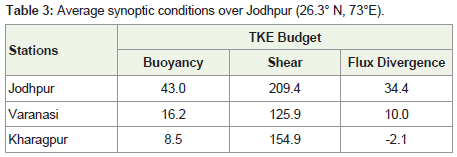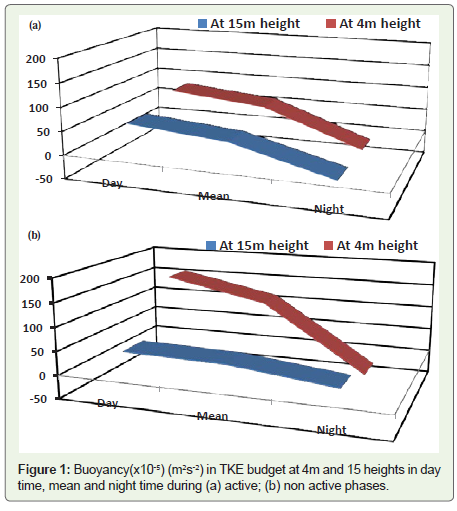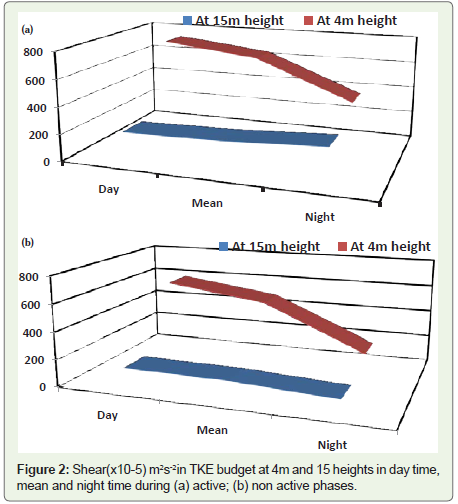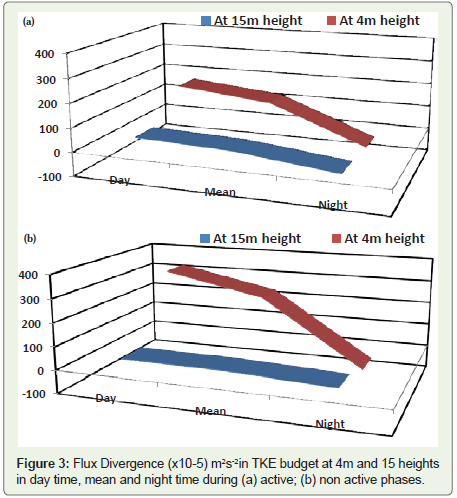Review Article
Study of Turbulence Kinetic Energy Budget over Jodhpur, India
P. Parth Sarthi*
Centre for Environmental Sciences, School of Earth, Biological and Environmental Sciences, Central University of Bihar, Patna 800014, Bihar, India
*Corresponding author: Centre for Environmental Sciences, School of Earth, Biological and Environmental Sciences, Central University of Bihar, Camp Office: BIT Campus-Patna, P.O-B.V. College, Patna 800014, Bihar, India, Email: drpps@hotmail.com
Article Information: Submission: 17/09/2014; Accepted: 27/01/2015; Published: 30/01/2015
Copyright: © 2015 Parth Sarthi P, et al. This is an open access article distributed under the Creative Commons Attribution
License, which permits unrestricted use, distribution, and reproduction in any medium, provided the original work is
properly cited.
Abstract
Atmospheric turbulence plays an important role to understand the behavior of pollutants in lower atmosphere which has a large impact on surrounding
environment. In the present paper, the one-dimensional Turbulent Kinetic Energy (TKE) budget in a steady and homogeneous condition is studied. The data
from a 30m micrometeorological tower during Indian Summer Monsoon (ISM) of the year 1990 over a station Jodhpur (26.3° N, 73°E), which represents
a dry convective station and situated at the eastern part of ISM trough over the Indian subcontinent, is used. The tower data is of Fast and Slow Response
data. The Fast Response Data (FRD) sampled at (8 Hz) is collected at 4 m and 15 m levels whereas the Slow Response Data (SRD) sampled at (~1 Hz) is
collected at six levels viz. 1, 2, 4, 8, 15 and 30m. The analysis of each component of TKE budget is done for active and non-active phases of monsoon at
4m and 15m levels. All terms of TKE budget show considerable variations at 4m levels. At 15m, the variations of term are not remarkable. It has been found
that at both of the levels shear production term dominates over all other terms during active phase of monsoon while buoyancy dominates during day time at
4m level in both of phases. The buoyancy and shear terms influence mixing and transport of pollutants in the lower part of the atmosphere in day time during
active and non active phases of ISM. TKE budget over Jodhpur, Kharagpur and Varanasi shows that buoyancy is not a major contributing factor during the
summer monsoon season while major contributing factor is shear production.
Keywords
MONTBLEX; TKE; Buoyancy; Shear; Flux divergence; Dissipation
List of Symbols
g: Acceleration due to gravity; k: Von Korman constant; θv:
Virtual Potential Temperature; e: Turbulent Kinetic Energy; u∗:
Frictional Velocity; u′w′: Covariance between u′ and w′; w′θ′:
Covariance between w′ and θ′; z: Height; ρ: Air Density; u′: Lateral
eddy; v′: Transverse eddy; w′: Vertical eddy; ∈: TKE dissipation rate
Introduction
Increasing urban population and industrial activities causes
serious air pollution problem. The pollutants emitting from stack,
motor vehicles, heating and cooling systems of buildings, sudden
fires, etc., can either deposit nearby source or transport to a distance
depending upon the temperature and wind profile in the prevailing
atmosphere. The characteristics of turbulence in the lower atmosphere
control the dispersion and transport of atmospheric pollutants in the
atmosphere. Therefore, TKE is one of the more important variables in lower atmosphere for the study of atmospheric pollution. The
budget of TKE is directly related to the transport of heat, moisture,
and momentum in lower atmosphere through atmospheric boundary
layer. The tendency of TKE is important because if TKE decreases
with time, the boundary layer will be less turbulent with time where
as if TKE increases with time, the boundary layer will become more
turbulent with time so TKE budget behaves like a source and sink.
TKE budget comprises shear production, buoyancy production,
dissipation, and the transport processes which has various applications
in in boundary-layer meteorology [1-3]. Panofsky [4] and Record
and Cramer [5] have been studied evolution of TKE in Atmospheric
Surface Layer (ASL) and found that divergence of TKE flux is
important under steady condition. Busch and Panofsky [6] examined
spectral characteristics of atmospheric turbulence stressed on the
importance of TKE flux and found that dissipation compensates
shear and buoyancy productions. Wyngaard and Cote [7] studies on the relative importance of each terms of TKE budget and found that
dissipation terms were balanced by shear production, while turbulent
transport and buoyant production terms were secondary important
under stable condition. Under unstable condition, dissipation slightly
exceeded the total production. McBean and Miyake [8] examined
TKE transfer in ASL. McBean and Elliot [9] studies on divergence
and pressure fluctuation terms of TKE budget and showed that
divergence of pressure fluctuation was in opposite sign and of equal
magnitude of the divergence of turbulent kinetic energy. Lenschow
[10] examined TKE budget under unstable condition and convective
condition. Champange et. al. [11] estimated TKE budget and also
calculated the pressure transport terms to the dissipation terms
and agreed well with Kansas results. Under convective condition,
TKE budget has been studied by Caughey and Wyngard [12].
Vishawanadham et al [13] studied different terms of budget equation
over semi humid station over India. Srivastava and Parth Sarthi [14]
studied the TKE in the atmospheric surface layer over deep humid
station and showed variation of the different terms of TKE budget in
different phases of ISM over deep humid station. Dacre et al. [15] in
their study said that turbulent mixing and convection processes can
double the amount of pollution ventilated from the boundary layer.
TKE budget variations during thunderstorm days (TD) and Nonth
Tunderstorm Days (NTD) of premonsoon seasons of 2007, 2009,
and 2010 over Kharagpur (22°30 N, 87°20 E) have been studies [16]
using the surface layer turbulence data under STORM experiment.
Variations in TKE budget parameters with respect to stability are
studied in contrasting days of weather activity.
In this paper, the relative magnitudes of buoyancy, shear and
flux divergence terms in day time, mean of a day and night time are
computed and analyzed for active and non active phases. Section1
deals with introduction and literature survey. The data used and
site are given in section2. To estimate each term of TKE budget,
methodology is placed in section3. Results and discussion and
conclusions are shown in section4 and 5, respectively.
Data and Site Description
Data:
To probe the interaction of atmospheric surface layer with
monsoon trough over Indian region, the Monsoon Trough
Boundary Layer Experiment (MONBLEX) [17-20], an intense multiinstitutional
meteorological experiment, was conducted in 1990. As a
part of this experiment, one 30 meters micrometeorological tower was
erected at dry convective region named Jodhpur (26.3° N, 73°E). The
various meteorological parameters were collected from the tower at
six levels as 1, 2, 4, 8, 15 and 30 meters levels. The SRD were collected
from all the six levels and sampled at 1Hz intervals, whereas FRD
were collected at 4m and 15m heights and sampled at 8Hz intervals.
The considered dates have been divided into active and non-active
phases of monsoon. The classification of active and non-active is
based on local conditions. The active phase is considered when
cloud amount>4/8 octas and rainfall>4mm or any of them reported
by Indian Daily Weather Report (IDWR) by India Meteorological
Department (IMD). When the cloud and rainfall do not fulfill
the above criteria, it is treated as non-active phase. The FRD were subjected to quality check before being used in the final analysis. A
physical examination was made and it was decided to remove unusual
spikes, which falls beyond mean ± 3 standard deviations. To confirm
to be universal laws, each data set of 10 minutes duration has been
subjected to spectral analysis and only those confirmed to -4/3-power
law have been referred to the final analysis [21]. The details of number
of runs and heights are shown in Table 1. The considered dates during
active and non-active phases of monsoon are presented in table 2
whereas table 3 shows prevailing synoptic weather conditions.Site Description:
The surface of the site of Jodhpur was covered with small pebbles
and patches of grass. To the north of the tower, a couple of bush like
trees was there. To the south of the tower, there was a water tank of
about 25m height. There were several trees of 5-6 m. height in the east
and west of the tower. The prevailing wind direction of the tower was
from a sector between southeast and west. The land stretch between
2000-3000 sector was fairly flat without any obstacles on the ground.
Jodhpur, Varanasi and Kharagpur comes under semi arid, humid and
deep humid tropical regions.Methodologies:
The turbulent kinetic energy budget under steady and
homogeneous condition can be expressed, when the coordinate
system is aligned with the mean wind (ū) [22] as followsWhere, , , , 'v u′ v′ w′ p′and θ are the turbulent parts of the three winds component, pressure and virtual potential temperature, z is the log mean height, ρ and ' Vθ are the mean densioty and mean virtual potential temperature, g is the acceleration due to gravity, ε is the dissipation and the TKE is given by:
Table 2: Details of considered dates during active and non active phases over
Jodhpur (26.3° N, 73°E).
The first term is the buoyant production term, which is usually
a source/sink during day/night time. The second term is shear
production of TKE, which is always source. The third is the divergence
of vertical flux of turbulent kinetic energy, which can be a source or
sink depending upon whether TKE flows into or going away from
the layer. The fourth is turbulent transport of TKE by pressure
fluctuations, which can again be a source/sink. The last term is
dissipation, which is always a sink. Since data on pressure fluctuation
are not available so pressure transport term is treated as residual term.
The buoyancy and shear terms computed with the help of FRD and
SRD. The vertical transport term is computed by following relation
given by Mc Bean and Elliot [9].
A non dimensional form of equation (1) can be obtained by
scaling it with u*3/kz, so
The vertical transport can be written as,
This function is obtained by a least square method with number
of runs. It is differentiated with z/L and multiplied by u*3/L to get for
each of the runs.
Finally, the flux divergence becomes
For near neutral conditions,
In the present study, the dissipation term is computed by
following Stull [22]. The pressure transport term was computed
as residual, which is likely to contain any possible errors in all the
remaining terms of TKE budget.
Results and Discussions
The buoyancy, shear and flux divergence of TKE budget are
averaged for day time, mean of whole day and night time for the
periods of active and non active respectively. The mixing and transport
of pollutants depends on relative magnitudes of buoyancy and shear
terms and flux divergence, mainly. The dissipation and residual
terms of TKE budget do not have significant role in dispersion of
atmospheric pollutants, therefore these two terms are not considered
here.
Buoyancy:
The buoyancy represents the generation or destruction of
TKE by vertical flux of virtual potential temperature. In general,
buoyancy remains positive at lower atmospheric level and decreases
approximately linearly with height up to the top of the mixed layer.
Hence, this term will be larger during day time and smaller or
negative during cloudy days or night time. The variation of buoyancy
at 4m and 15 m in day time, mean of whole day and night time during
active and non active phases is shown in Figures 1a and 1b. At 4m
level, during active phase (Figure 1a), the buoyancy is positive during
day time while it is negative in night time but the difference between
two levels during day time is more in compare to non active phase
(Figure 1b). It seems that less cloudy days and clear sky during non
active phase are more convective and therefore more buoyancy is
found. Although the difference of buoyancy at two levels (4 and 15m)
during night time in active phase is relatively large that that of non
active phase. It seems that buoyancy is dominating during day time
in non active phase. More buoyancy at lower level would lead more
convective condition and therefore more pollutants can be dispersed
in the vertical atmosphere.
Figure 1: Buoyancy(x10-5) (m2s-2) in TKE budget at 4m and 15 heights in day
time, mean and night time during (a) active; (b) non active phases.
Shear:
In TKE budget, shear is the interaction of the turbulent
momentum flux with the mean vertical wind shear that generates
turbulence. This term remains generally very large and positive near
the ground and becomes larger on a windy day (larger vertical shear)
and smaller on a calm day. This term shows the production of eddies
by shear. The wind near the ground is generally stronger than the
shear at slightly higher level. During day time, the shear is also found
more than at night. Figures 2a and 2b depicts the variation of shear
in day time, mean of whole day and night time at 4 and 15m during
active and non active phases. At 4m level, the mean values of wind
shear are more in compare to its value at 15m in active and non
active phases (Figures 2a and 2b) although its values are found more
in active phases due to windy condition, in compare to non active
phase at corresponding level. If the source of atmospheric pollutants
over this area exists, the large wind shear at 4m level will disperse
or transfer pollutants, which are remaining in the lower level, in the
vertical atmosphere. At each level and their phases, the day time shear
is found more with respect to night time, except in active phase at
15m level, and therefore dispersion of pollutants could be more in the
vertical atmosphere.Flux divergence:
The flux divergence term in TKE budget represents the vertical
transport of TKE. Since it shows the flux divergence of TKE for a
layer since it depends on the vertical gradient of vertical flux. So, for
a given layer, if more flux in entering the layer than leaving it, there
would be net convergence of the vertical flux, and therefore, the TKE
of the layer will increase which may carry more pollutants in the
vertical atmosphere. Figures 3a and b represents the variation of flux divergence at 4 and 15m levels in day time, mean of whole day and
night time during active and non active phases respectively. In active
phase (Figures 3a), the flux divergence seems to more during day time
at 4m with respect 15m and therefore more turbulence in entering in
the layer 4-15m during day time which in turn will increase TKE in
the layer. It will lead to more dispersion of pollutants during day time
in compare to night time. In non active phase (Figures 3b), the shear is
found more at 4m level that that of 15m level during day time while
the night time values are less. Therefore, the atmospheric pollutants
will settled down during night times which have been dispersed more
during day time period in the layer 4-15m. In both of the figs, more
turbulence is entering during day time in compare to night time
but entering of TKE in layer 4-15m is large in non active phase with
respect to active phase.
Figure 2: Shear(x10-5) m2s-2in TKE budget at 4m and 15 heights in day time,
mean and night time during (a) active; (b) non active phases.
Figure 3: Flux Divergence (x10-5) m2s-2in TKE budget at 4m and 15 heights
in day time, mean and night time during (a) active; (b) non active phases.
Comparison of TKE Budget over Jodhpur, Varanasi and Kharagpur:
Table 4 and 5 show magnitude of the budget terms for three
stations namely Jodhpur, Kharagpur and Varanasi at 15m level during
active and nonactive phases. The magnitude of buoyancy term over
Jodhpur is more followed by Kharagpur and Varanasi, respectively.
During active phase, buoyancy at Varanasi is comparable with
Jodhpur. In non active phase, buoyancy is more over Jodhpur followed
by Kharagpur and Varanasi. The magnitude of shear production is
highest over Kharagpur during non active phase and over Jodhpur
during active phase. The flux divergence shows transport of TKE
away over Kharagpur while it is brought over Vanarasi and Jodhpur
over both phsases. The maximum transport of TKE is noticed over
Jodhpur followed by Varanasi and Kharagpur.Conclusions
The study of turbulence in the atmosphere over Jodhpur helps
to understand the behavior of particulate matter during monsoon
season. The analysis concludes that buoyancy, shear and flux
divergence of TKE budget plays significant role for the dispersion of
atmospheric pollutants. The buoyancy values in mean of whole day
and day time are more during non active phase at corresponding
levels with respect to active phase. More buoyancy at lower level
will lead more convection and therefore more pollutants can be
dispersed in vertical atmosphere. Buoyancy during day time acts as
source where as it behaves as sink during night time. The shear of
TKE budget, at 4m level, shows that wind shear during day time is
more in compare to its value at 15m in active and non active phases
although its values are found more in active phases which may be due
to windy condition, in compare to non active phase at corresponding
level. If the source of atmospheric pollutants exists nearby by Jodhpur
station, the large wind shear at 4m level will disperse or transfer
pollutants remaining in the lower level, in the vertical atmosphere.
In the layer 4-15m, flux divergence of TKE budget is entering more
during day time in non active phase at corresponding time in active
phase. Therefore, the atmospheric pollutants will settled down during
night times, which has been dispersed more during day time period
in the layer 4-15m. The study of relative magnitudes of buoyancy,
shear and flux divergence at 4 and 15m in day and night time during
active and non active phases over Jodhpur can be correlated with the
vertical mixing and transport of pollutants in vertical atmosphere
near the earth surface.
From the comparison of TKE budget over Jodhpur, Kharagpur
and Varanasi, it is clear that buoyancy is not a major contributing
factor during the summer monsoon season. The major contributing
factor is shear production. Therefore, transport of pollutants may be
influenced by shear production over these stations during active and
non active phases.
Acknowledgement
Author is very much thankful to the director, Indian Institute of
Tropical Meterology, Pune India for providing the necessary data and
computer facility.
















